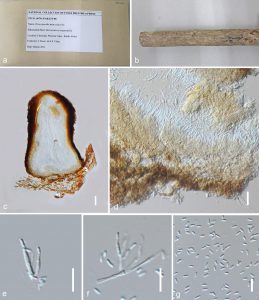Diversimorbus metrosiderotis S.F. Chen et al., Fungal Biol. 117: 301 (2014).
Pathogenic on woody barks. Sexual morph: Ascostromata 120–420 μm high above the bark, 300–1200 μm diam., on bark gregarious or single, superficial to slightly immersed, orange to umber, pulvinate, ascostromatic tissue pseudoparenchymatous, covering the tops of the perithecial bases. Perithecia 100–230 μm diam., valsoid, up to 13 per stroma, fuscous black, embedded beneath surface of bark at base of stromata, perithecial bases globose to subglobose, perithecial necks black, emerging at the stromatic surface as black ostioles with orange stromatic tissue of textura porrecta. Necks 20–90 μm wide, up to 410 μm long, no neck extending above stromatic surface. Asci 46–55 × 9.5–12 μm, 8-spored, fusoid to ellipsoidal, biseriate, unitunicate, released from inner wall of perithecia when mature, non stipitate. Ascospores 8.5–10.5 9 3–4 μm, hyaline, one-septate with septum variously placed in the spore but usually central, ascospores slightly constricted at septum, fusoid to ellipsoidal, ends round to slightly tapered. Asexual morph: Conidiomata 160–500 μm high, 60–620 μm diam., black, pulvinate, globose to conical, superficial to slightly immersed, without necks, uni to multilocular, with locules often convoluted, ostioles covered with orange tissue, stromatic tissue pseudoparenchymatous, conidiomatal bases above the bark surface. Conidiophores 13.5–21 μm long, aseptate, cylindrical, occasionally with separating septa and branching, hyaline. Conidiogenous cells cylindrical or flask-shaped with attenuated apices. Paraphyses up to 220 lm long, 1–2.5 lm wide, cylindrical, occurring among conidiogenous cells, slightly tapered towards apex, branching occasionally. Conidia 3.5–4 × 1–1.5 lm, hyaline, cylindrical to fusoid, aseptate (description based on Chen et al. 2013).
Material examined: SOUTH AFRICA, Western Cape Province, Citrusdal area, on bark of Metrosideros angustifolia (Myrtaceae), 8 March 2011, Jolanda Roux & ShuaiFei Chen, PREM 60741, holotype; Western Cape Province, Porterville area, on bark of Metrosideros angustifolia (Myrtaceae), 9 March 2011, Jolanda Roux & ShuaiFei Chen, PREM 60741, paratype.
Notes: Diversimorbus was isolated from South Africa associated with Myrtales tree species. The fungus was shown to be pathogenic on its host (Chen et al. 2013).

